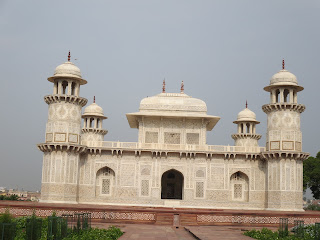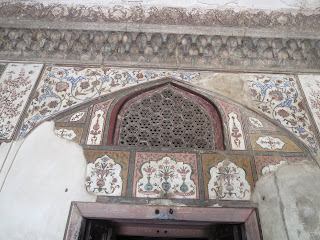Thursday, September 14, 2017
I was feeling better. Just a little tired, and I was a little worried about the heat. But I could stay on the air conditioned bus if I felt I could not do the attraction. I was going to go on with the tour. If I got in trouble again, I would go home.
a few pictures of things we saw on our way to what they call the Baby Taj. The Indians did not really have a name for it, but the British gave it that name.
The Red Fort
Additional information from the Visit Agra! website.
Agra Fort is a UNESCO World Heritage site located in Agra, India. The fort is also known as Lal Qila, Fort Rouge and Red Fort of Agra. It is about 2.5 km northwest of its much more famous sister monument, the Taj Mahal. The fort can be more accurately described as a walled palatial city.
Agra Fort built by Akbar in Red Sandstone when he was through with the consolidation of his power after accession to power in 1654, Agra Fort worked both as a military strategic point as well as the royal residence.
. Ever since Babur defeated and killed Ibrahin Lodi at Panipat in 1526, Agra played an important center of Mughal Empire it was in a ruined condition and Akbar decided to make it his capital and arrived in Agra in 1558 Akbar had it rebuilt with red sandstone. Architects laid the foundation and it was built with bricks in the inner core with sandstone on external surfaces. Some 1,444,000 builders worked on it for eight years, completing it in 1573.
At the end of his life, his son, Aurangzeb, in the fort, a punishment that might not seem so harsh, considering the luxury of the fort, imprisoned Shah Jahan. It is rumored that Shah Jahan died in Muasamman Burj, a tower with a marble balcony with an excellent view of the Taj Mahal.
The fort contains splendid palaces both in red sandstone and white marble built by two generations of prolific builders Akbar and later Jehangir and Shahjahan. Of the nearly 500 Akbari buildings built in the Bengal and Gujarati traditions only a few have survived, arrayed in a band on the riverfront.
Some of the exquisite structures that deserve a mention are:
Sheesh Mahal - Literally meaning 'Glass Palace' it was the royal dressing room adorned by tiny mirror-like glass-mosaic decorations on the walls.
The Diwan-i-Am - Which was used as a communications ground between the public and the aristocracy and once housed the Peacock Throne.
Diwan-i-Khas - A hall of private audience, it was used to welcome kings and dignitaries.
The Anguri Bagh - It houses 85 square, geometrically arranged lush gardens.
Khas Mahal - An immaculate white marble palace.
Mina Masjid - Literally meaning 'Heavenly Mosque' it is a tiny mosque closed to the public.
Nagina Masjid - Literally meaning 'Gem Mosque' it was designed exclusively for the ladies of the court.
Musamman Burj - A large, octagonal tower with a balcony facing the Taj Mahal.
Open from sunrise to sunset
This is a marble statue store. All of these are carved by hand.
Street cow
The bus stopped and let us look at the monkeys on the side of the road. Yes, this young monkey is eating a banana.
Mark has much better monkey pictures and they are coming up!
A little glimpse of the Baby Taj
A brief history from the Visit Agra! website
Itmad-ud-daula has a special place in the chronicles of both history as well as architecture. This is precisely because Itmad ud Daula is the very first tomb in India that is entirely made out of Marble. This is actually a mausoleum that overlooks the River Yamuna and is a tomb of Mir Ghiyas Beg, a minister in the court of Shah Jahan.
The story of Itmad-ud-daula is an inspirational rag to riches saga. The tomb of Itimad-ud-Daulah is as interesting as the life of the person for whom it was built. Mirza Ghiyas-ud-din or Ghiyas Beg (later known as Itimad-ud-Daulah) was a poor merchant and lived in Persia (modern-day Iran). His wife gave birth to a daughter whom he wanted to abandon for he has no money to feed her but the persistent wails of the infant changed his heart. The baby girl brought a stroke of good luck to her parents, for Ghiyas Beg found a caravan that straightaway took him to the court of the great Mughal Emperor, Akbar. . After Akbar's death in 1605, his son Jahangir became the Mughal emperor, who made Ghiyas Beg his chief minister or Wazir. Ghiyas Beg was also honored with the title of Itimad-ud-Daulah or the pillar of the state.
Jahangir fell in love with his widowed daughter who processes unspeakable beauty. She was later christened Noor Jahan and went down in the history as one of the most beautiful and artistically gifted women in the world. Jahangir conferred the title of Itmad-ud-daula or 'Pillar of the Empire' to his father-in-law. Noor Jahan ordered the tomb after the death of her father in 1622.
Itmad-ud-daula is a pure white and elaborately carved tomb that conforms to the Islamic style of architecture. The Indo-Islamic architecture becomes prominent because of the fusion that this tomb displays. While the use of arched entrances and octagonal shaped towers signify the Persian influence, the absence of a dome and the presence of a closed kiosk on top of this building and the use of canopies talks about the possible Indian influence. From out side, when you take a bird eye view, Itmad-ud-daula looks like a jewel box set in a garden. This tranquil, small, garden located on the banks of the Yamuna was to inspire the construction of the Taj Mahal in the later years.
The entrance gate. Very much like the Taj Mahal
The Baby Taj
The inside.
The pigeons were loving the inside
Mowing the front lawn.
Mark's turn!
Road cow. They love being on the road side. We were told the carbon monoxide makes them slightly high and they like that feeling
The marble shop at the Trident Agra. Mark tells me that we both went there, but I really do not remember going to the marble shop that night.
The streets of Agra
A statue of someone
Mark took some great Monkey pictures
Right after someone dropped some food for them
Water buffalo on the move
Listening to the tour guide. I wore lighter clothes and I found my sun glasses!
Mark happily paid a couple of rupees for this photo! What a great picture.
Mark called these little creatures Chippo Squirrels. Their real name is Indian Palm Squirrel. Latin name: Funambulus palmarum. The Latin name for squirrel is Funambulus! How great is that!?
The palm squirrel is about the size of a large chipmunk, with a bushy tail slightly shorter than its body. The back is a grizzled, grey-brown colour with three conspicuous white stripes which run from head to tail. The two outer stripes run from the forelegs to the hind legs only. It has a creamy-white belly and a tail covered with interspersed, long, black and white hair. The ears are small and triangular. Juvenile squirrels have significantly lighter coloration, which gets progressively darker as they age. Albinism is rare, but exists in this species.
Squirrels are considered sacred in India and are not to be harmed. They are even fed by many Hindu families, mainly because of their association with Lord Rama.
A legend explains the stripes on the back of most of the squirrels. During the construction of the Rama Setu (bridge) at Rameswaram by Lord Rama and the Vanara Sena, a little squirrel also contributed in its own little way. It rolled in the beach sand and then ran to the end of the bridge to shake off the sand from its back (chanting Lord Rama's name all along).
Lord Rama, pleased by the creature's dedication, caressed the squirrel's back and ever since, the Indian squirrel carried white stripes on its back, which are believed to be the mark of Lord Rama's fingers. Lord Rama and the squirrel are mentioned in one of the hymns of the Alvars















































No comments:
Post a Comment